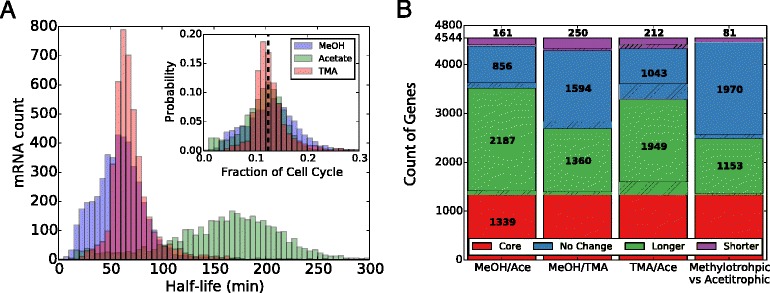Fig. 1.

Shift in Half-Life With Growth Substrate. a) Genome-wide histograms of RNA half-lives for M. acetivorans growing in methanol (blue), TMA (red), or acetate (green) media. The shorter lifetimes in high-energy substrates are apparent when compared to the acetate distribution. The inset shows the distribution of half-lives after they have been scaled by doubling time (7.5hr [43, 95, 96], 8.9hr [43] and 24.6hr [43, 95, 97] for growth in MeOH, TMA and Acetate, respectively), demonstrating that the average transcript half-life is a constant fraction of the cell cycle, or about 12.7% ±3.5% the doubling time (dashed line). See Additional file 1: Figure S4 for a larger version of the inset. b) A breakdown of changes in half-life by pairwise comparison of growth conditions. Unregulated genes that show no statistically significant (t-test, p>0.01) shift in half-life under any of the conditions (1339 total; red bar) and those marked as “No Change” (blue bar) do not show significant changes when comparing the indicated conditions. Genes that are stabilized or destabilized when comparing the second condition to the first condition are labelled as “longer” (green) and “shorter” (purple), respectively. Hatched regions indicate the fraction of genes that are differentially expressed in addition to having different half-lives. As discussed more thoroughly in the text, almost half of the stabilized and destabilized genes are common when comparing methylotrophic conditions to acetotrophic growth, suggesting there is a similar stabilization mechanism based on either growth rate or substrate
